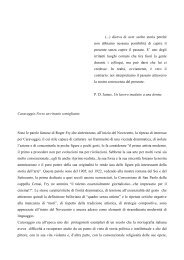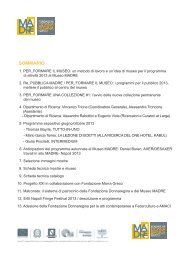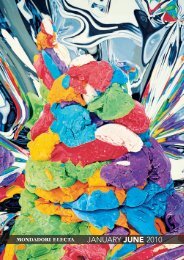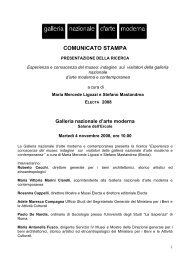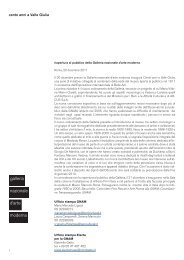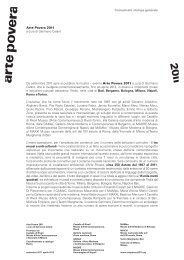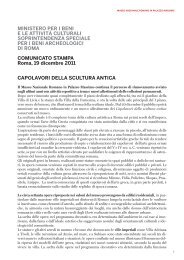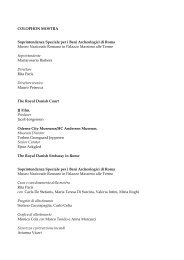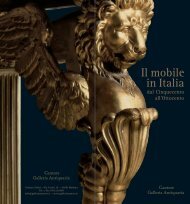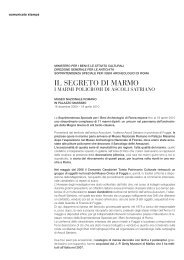You also want an ePaper? Increase the reach of your titles
YUMPU automatically turns print PDFs into web optimized ePapers that Google loves.
L U X I N<br />
T E N E B R I S<br />
L U X I N<br />
T E N E B R I S<br />
“Quel che a me importa è il soggetto, <strong>Nerone</strong>. Egli è da<br />
un pezzo che mi perseguita. […] spogliato quell’aspetto<br />
orribile e deforme con cui spaventava i sogni della<br />
nostra infanzia […] n’è sorto un altro elegante nelle<br />
sue voluttà, amabile ne’ suoi capricci, quasi attraente<br />
nella sua ferocia”. Così scriveva Domenico Gnoli<br />
dopo aver ammirato, nel 1876, Le torce di <strong>Nerone</strong>,<br />
la grandiosa tela che procurò fama internazionale a<br />
Henryk Siemiradzki, un artista polacco che aveva fatto<br />
dell’Italia la seconda patria e andrebbe riscoperto. Nel<br />
suo studio di via Margutta era nato nel 1897 anche un<br />
altro capolavoro, la Dirce cristiana: li legava il tema del<br />
supplizio dei martiri cristiani magistralmente inscenato<br />
per muovere gli animi a pietà, essendo evidente che<br />
fossero puniti non per il bene pubblico ma per la<br />
tracotanza di uno solo. “Nessuno dipinge come lui i<br />
raggi del sole” affermava Sienkiewicz, di cui il pittore<br />
era stato cicerone a Roma: nel dipinto in mostra<br />
la luce filtra da un ameno pergolato e si intravede<br />
l’anfiteatro che dal colosso di <strong>Nerone</strong> avrebbe preso il<br />
nome, a rivelare l’acribia archeologica di Siemiradzki.<br />
Qui si respira un’atmosfera di conversione spirituale<br />
che fa dimenticare le efferatezze del tiranno quasi ad<br />
interpretare le ultime parole di Quo vadis?: “E così<br />
passò <strong>Nerone</strong>, come una bufera, come un uragano,<br />
come una fiamma, come passa la guerra o la morte;<br />
mentre la basilica di Pietro governa ancora la città e il<br />
mondo.”<br />
Le migliori illustrazioni del celebre romanzo si devono<br />
però a un altro pittore polacco, Jan Styka, ormai<br />
dimenticato autore di <strong>Nerone</strong> a Baia. Nel quadro le<br />
atmosfere concitate e fosche dei tableaux vivants<br />
gremiti di personaggi cedono il passo a un’indagine più<br />
intima non priva di una sorvegliata carica simbolica.<br />
Il chiarore dell’alba ha già tinto di rosa la tunica di<br />
un imperatore imbolsito e le calme distese del golfo<br />
di Napoli: in quella città <strong>Nerone</strong> si era esibito per<br />
la prima volta in pubblico riscuotendo un singolare<br />
successo; alle ville marittime si erano ispirati gli<br />
architetti che progettavano per lui la Domus Aurea.<br />
Proprio a Baia si compì un evento drammatico: lì<br />
<strong>Nerone</strong> decise di uccidere la madre. Il suo volto è<br />
lugubre, lo sguardo perso nel vuoto della veglia per<br />
l’esito incerto dello scellerato delitto. Facile il parallelo<br />
tra il Vesuvio fumante e la tetra fierezza del despota,<br />
lambito da una languida tigre, sinonimo di forza e<br />
crudeltà ma desiderosa di carezze.<br />
24 LA CURIA IULIA<br />
“What is important to me is the subject, Nero. It’s a<br />
long time that he haunts me. [...] Stripped of that<br />
horrible and deformed appearance that disturbed<br />
our childhood dreams, [...] another person is made,<br />
elegant in his voluptuousness, lovable in his moods,<br />
almost attractive in his ferocity.”<br />
Thus wrote Domenico Gnoli in 1876, having admired<br />
The Torches of Nero, the grandiose painting that made<br />
famous Henryk Siemiradzki, a Polish artist who made<br />
Italy his second homeland and is due for a revival. In<br />
his studio on Via Margutta a second masterwork was<br />
created in 1897, the Christian Dirce. This dealt with<br />
the theme of the torture of Christian martyrs, and<br />
was masterfully staged to evoke pity, making it clear<br />
that they were being punished not for the public good<br />
but because of the arrogance of one man.<br />
“No-one paints the rays of the sun like him” said<br />
Sienkiewicz, who had the painter as his guide in<br />
Rome. In the painting on display, light filters from<br />
a pleasant arbour and the amphitheatre that took<br />
its name from the Colossus of Nero can be seen,<br />
revealing Siemiradzki’s precise feel for archaeological<br />
observation. Here is an atmosphere of spiritual<br />
conversation that leads one to overlook the brutality<br />
of the tyrant, summed up in the final words of Quo<br />
Vadis?: “And so ended Nero, like a whirlwind, like a<br />
hurricane, like a flame, as war or death pass away;<br />
while the basilica of Saint Peter still rules the city<br />
and the world.” The best illustrations of this famous<br />
novel were the work of another long forgotten Polish<br />
artist, Jan Styka, who produced Nero at Baiae. In<br />
this painting, the excited and gloomy atmosphere<br />
of the tableaux vivants, packed with people, gives<br />
way to a more intimate view, not without its guarded<br />
symbolic significance. The light of dawn has already<br />
tinted pink the tunic of the flabby emperor and the<br />
calm waters of the bay of Naples. In that city Nero<br />
performed in public for the first time to resounding<br />
success, and its coastal villas inspired the architects<br />
who designed the Domus Aurea for him. At Baiae a<br />
dramatic event took place. Here Nero decided to kill<br />
his mother. His face is mournful, his gaze blank while<br />
he awaits the uncertain result of his infamous crime.<br />
It is easy to see the parallel between the smoking<br />
Vesuvius and the despot’s gloomy pride, as he is<br />
licked by a languid tiger, synonymous of force and<br />
cruelty, yet eager to be caressed.



